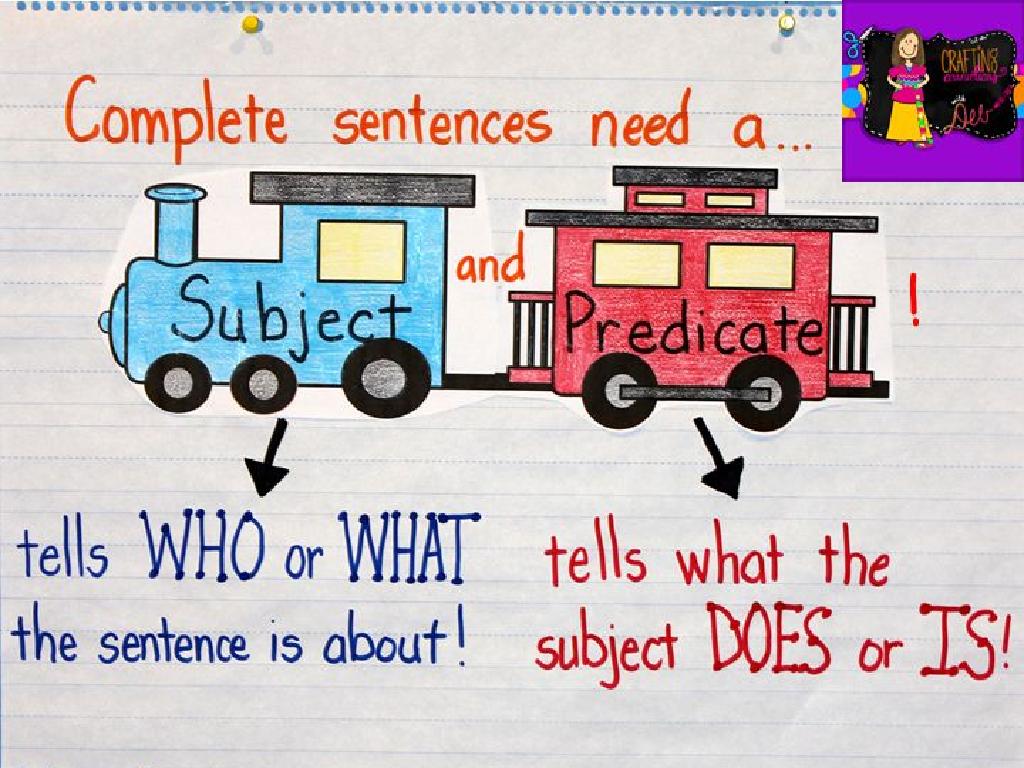Compare Fractions With Like Denominators
Subject: Math
Grade: Third grade
Topic: Compare Fractions With Like Denominators
Please LOG IN to download the presentation. Access is available to registered users only.
View More Content
Welcome to Fractions: Comparing Like Denominators
– Understanding parts of a whole
– Think of a pizza cut into equal slices. Each slice is a part of the pizza whole.
– What are like denominators?
– Like denominators mean the bottom numbers in fractions are the same.
– Comparing fractions visually
– Use shapes like circles or bars divided into equal parts to see which fraction is bigger.
– Practice with examples
|
This slide introduces third graders to the concept of comparing fractions with like denominators. Begin by explaining that a fraction represents a part of a whole, using tangible examples like slices of a pizza or pieces of a chocolate bar. Clarify that the denominator is the bottom number of a fraction and when fractions have the same denominator, they have ‘like denominators.’ Demonstrate how to compare fractions by drawing visual representations, such as shaded parts of a circle or bar, to show which fraction is larger or smaller. Encourage students to practice by providing examples of fractions with like denominators and asking them to compare using the visuals. This will help solidify their understanding of the concept.
Understanding Fractions
– A fraction is part of a whole
– Imagine cutting a cake into equal pieces, each piece is a fraction of the cake.
– Numerator and denominator explained
– Top number (numerator) shows how many pieces you have. Bottom number (denominator) shows how many pieces the whole is divided into.
– Example: 1/4 as a fraction
– If you have 1 piece of a cake that was cut into 4 pieces, that’s 1/4.
|
Begin by explaining that a fraction represents a part of a whole, using tangible examples like pieces of a cake or a pizza to illustrate the concept. Clarify that the numerator, the top number of a fraction, indicates how many parts we have, while the denominator, the bottom number, shows into how many equal parts the whole is divided. Use the example of 1/4 to show one part out of four equal parts, perhaps drawing a picture of a cake divided into four pieces and shading one to represent the fraction. This will help students visualize fractions and understand the role of numerators and denominators before moving on to comparing fractions with like denominators.
Comparing Fractions with Like Denominators
– What are like denominators?
– Fractions with the same bottom number (denominator)
– Example of like denominators
– 2/5 and 3/5 both have a denominator of 5
– Comparing is simpler with like denominators
– With the same denominators, just look at the numerators
– Practice comparing fractions
– Let’s find which is bigger: 1/4 or 3/4?
|
This slide introduces the concept of like denominators to third-grade students, making it easier for them to compare fractions. Start by explaining that the denominator is the bottom number of a fraction and when two fractions have the same denominator, they have ‘like denominators.’ Use visual aids to show examples of like denominators, such as 2/5 and 3/5, and highlight that the denominator is the same in both. Emphasize that comparing fractions is easier when they have like denominators because you only need to look at the numerators (the top numbers). For practice, present fractions with like denominators and guide students to determine which fraction is larger by comparing numerators. Encourage students to explain their reasoning and provide additional examples for practice.
Comparing Fractions with Like Denominators
– Compare fractions: look at numerators
– Larger numerator means larger fraction
– Example: 3/5 is larger than 2/5
– Since 3 is greater than 2, 3/5 is greater than 2/5
– Practice comparing with classmates
– Use similar fractions to learn with friends
|
When teaching third graders to compare fractions with the same denominators, emphasize that they only need to look at the numerators to determine which fraction is larger. Use visual aids like fraction bars to illustrate this concept if possible. The example provided on the slide should help them understand the concept clearly. Encourage students to practice by comparing different pairs of fractions and explaining their reasoning to each other. This peer interaction will reinforce their understanding and make the learning process more engaging.
Let’s Practice Comparing Fractions!
– Comparing 2/6 and 4/6
– Which fraction has more pieces?
– Consider the size of pieces
– Pieces are the same size, so count them
– Same denominator: focus on numerators
– Numerators tell us the number of pieces we have
– Which fraction is larger?
|
This slide is designed to help students practice comparing fractions with like denominators. Start by presenting the fractions 2/6 and 4/6 and ask the students which one is larger. Explain that since the denominators are the same, they can just look at the numerators to determine the size of the fraction. The numerator represents how many parts of the whole we have, so in this case, 4/6 is larger than 2/6 because 4 is more than 2. Use visual aids like pie charts or fraction bars if possible to illustrate this concept. Encourage students to think about the fractions in terms of pieces of a pie or pizza to make it more relatable. For the activity, have students find other fractions with the same denominator and compare them, or create their own fractions to compare with a partner.
Using Visuals to Compare Fractions
– Visual aids show fraction size
– Visuals help us understand fractions better
– Pie charts as fraction examples
– Imagine a pie divided into equal parts
– Comparing 1/4 and 3/4 with pie charts
– See the difference in the shaded areas of the pie
|
This slide is designed to help third-grade students visually understand the concept of comparing fractions with like denominators. By using pie charts, students can see fractions as parts of a whole and compare the sizes directly. For example, when looking at 1/4 and 3/4 on a pie chart, students can clearly see that 3/4 has more shaded parts than 1/4, indicating that 3/4 is the larger fraction. Encourage students to draw their own pie charts for different fractions with like denominators to reinforce the concept. This visual method is particularly effective for young learners who can benefit from seeing abstract concepts like fractions represented in a concrete form.
Class Activity: Fraction Match-Up!
– Play a game with fraction cards
– Match fractions with same denominators
– Determine the larger fraction
– Compare numerators to decide which is larger
– Explain your reasoning
– Use examples like 1/4 is less than 3/4
|
In this engaging class activity, students will use fraction cards to practice comparing fractions with like denominators. Provide each student with a set of fraction cards, ensuring that all fractions have the same denominator. Students will then find pairs of fractions and determine which one is larger by comparing the numerators. The student with the correct answer will explain their reasoning to the class, reinforcing their understanding of fractions. Possible variations of the activity include: 1) Fraction War, where students draw cards and compare with a partner, 2) Fraction Memory Match, where students find matching pairs by memory, 3) Fraction Sorting, where students sort cards into ascending or descending order, and 4) Group Challenge, where teams compete to match and compare fractions correctly.
Mastering Fraction Comparison
– Congratulations on learning fraction comparison!
– Compare numerators with same denominators
– If fractions have the same bottom number, just look at the top numbers
– Practice is key to understanding fractions
– The more you compare, the better you get!
– Keep practicing comparing fractions!
– Try different pairs of fractions with like denominators
|
This slide wraps up the lesson on comparing fractions with like denominators. Reinforce the concept that when two fractions have the same denominator, the comparison comes down to looking at the numerators – the larger the numerator, the larger the fraction. Encourage the students to continue practicing with a variety of fractions to solidify their understanding. Provide additional worksheets and interactive activities to make the practice enjoyable. Remind them that mastering fractions is a step-by-step process and that they’ve made great progress.






